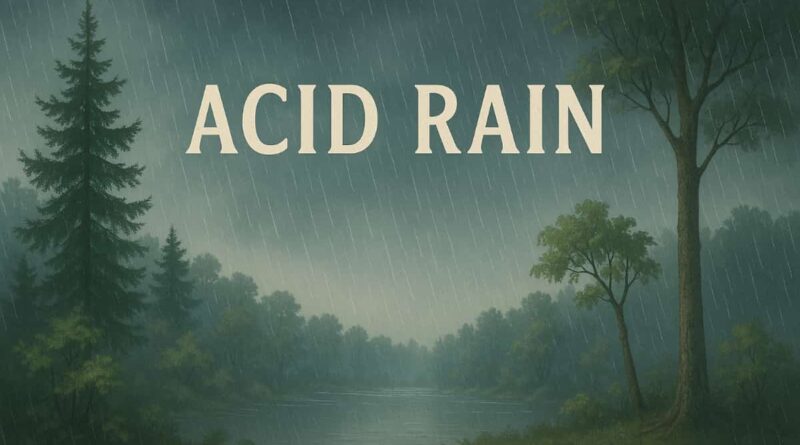Acid Rain English Paragraph For SSC & HSC Students
🌧️ Acid Rain Paragraph: 200 Words
Acid Rain: A Threat to the Environment
Acid rain is rain that contains harmful acids. It forms when sulfur dioxide (SO₂) and nitrogen oxides (NOₓ) mix with water vapor in the air. These gases come from burning fossil fuels in factories, power plants, and vehicles. Once released, they travel long distances and return to the earth as acidic precipitation.
The effects of acid rain are dangerous. It harms plants, trees, and soil. Acid rain removes important nutrients from the soil, making it hard for trees to grow. In lakes and rivers, the water becomes too acidic for fish to survive. Many aquatic species die as a result.
Buildings and monuments also suffer damage. Acid rain eats away at stone, especially limestone and marble. Historical landmarks lose their beauty and strength over time. The problem doesn’t end there. Humans may also feel its effects. Though it doesn’t directly harm the skin, it pollutes the air. Breathing in these chemicals can cause asthma and other lung problems.
We can fight acid rain by reducing pollution. Using clean energy like solar and wind helps a lot. Cars and factories should follow emission rules. People can also help by saving electricity and planting trees.
In short, acid rain is a global issue. It damages nature, health, and history. But with awareness and action, we can reduce its impact and protect the planet for future generations.
🌧️ Acid Rain Paragraph: 400 Words
Understanding Acid Rain: Causes, Effects, and Solutions
Acid rain is one of the major environmental problems facing the world today. It refers to rainfall that contains high levels of sulfuric and nitric acid. These acids are formed when sulfur dioxide (SO₂) and nitrogen oxides (NOₓ) are released into the air. They primarily come from the burning of fossil fuels in factories, vehicles, and power plants. Once in the air, these gases mix with clouds and form acidic moisture that falls to the earth as rain, snow, or fog.
The impact of acid rain is widespread and harmful. It affects forests, lakes, rivers, soil, animals, buildings, and even human health. In forests, acid rain weakens trees by leaching away vital nutrients from the soil. It also damages leaves and bark, making trees more vulnerable to disease and harsh weather. Acidic conditions affect trees for extended periods in mountainous areas where clouds often touch the ground.
In lakes and rivers, acid rain lowers the pH of water, making it toxic for fish and other aquatic animals. Acidic water can kill eggs and reduce the population of sensitive species. As a result, the food chain is disrupted, and biodiversity suffers.
Acid rain also causes serious damage to buildings and monuments. Structures made of limestone and marble slowly erode over time due to acid exposure. Many historical landmarks have lost their original form and strength. The cost of repairs is high, and the cultural loss is often permanent.
Human health is also indirectly affected. The pollutants that cause acid rain can lead to breathing problems. People who live in polluted cities may develop asthma, bronchitis, or other lung conditions.
To solve this problem, we must reduce air pollution. Using renewable energy sources like wind, solar, and hydropower is one solution. Governments must enforce strict emission controls on vehicles and factories. People should be encouraged to use public transport, save energy, and plant more trees.
Education and awareness campaigns can help people understand how their actions affect the environment. Schools, media, and communities should work together to promote eco-friendly habits.
In conclusion, acid rain is a serious issue caused by human activity. Its effects are damaging, but they are also preventable. With strong policies and responsible behavior, we can reduce acid rain and ensure a cleaner, healthier planet.
FAQ
Acid rain is caused by the release of sulfur dioxide (SO₂) and nitrogen oxides (NOₓ) into the atmosphere, mainly from burning fossil fuels like coal, oil, and gas.
This problem occurs when sulfur dioxide (SO₂) and nitrogen oxides (NOₓ) are released into the atmosphere. These gases mostly come from burning fossil fuels in power plants, vehicles, and factories. As they rise into the sky, they combine with moisture and return as acidic precipitation.
The environmental damage is widespread. It weakens trees by removing nutrients from the soil. In addition, rivers and lakes become too acidic for fish to survive. Over time, buildings and monuments made of stone corrode. Moreover, people may face breathing problems due to polluted air.
There are several effective solutions. First of all, switching to clean energy sources like solar and wind helps reduce air pollution. Secondly, factories and vehicles should use pollution control systems. Furthermore, public awareness can inspire responsible behavior.
Not directly on contact, but the gases responsible can lead to serious respiratory conditions. For example, asthma, coughing, and bronchitis may develop in polluted areas. Children and elderly people are especially at risk.
Industrial zones and mountainous regions suffer the most. In particular, areas downwind from major pollution sources face longer exposure. As a result, forests in those zones often experience long-term damage.




